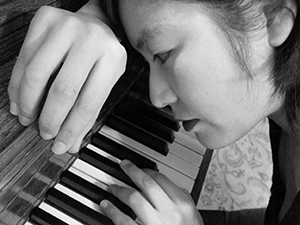Eunmi Ko in Review
Eunmi Ko, Piano Weill Recital Hall at Carnegie Hall, New York, NY June 3, 2014
Pianist Eunmi Ko gave an exceedingly interesting recital at Weill Recital Hall at Carnegie Hall on the evening of June 3, 2014. Her programming was original, as were her interpretations. In general, her strengths are an abundance of technique, as well as a beautiful array of pianistic colors, particularly in the soft dynamic levels.
She began with Mécanisme, the first movement of the two-movement work Dichotomie (2000), by conductor/composer Esa-Pekka Salonen (b. 1958), which she plunged into without even waiting for the welcoming applause to die down. The piece has a certain steely resolve that suits its title, as well as an over-reliance on glissandi; but it creates sonorities that are not often heard from the piano, particularly in Ko’s headlong, momentum-filled rendition. In the composer’s own words: “Mécanisme, is indeed like a machine, but not a perfect one: more like one of the Tinguely sculptures (or mobiles, they really defy all attempts to categorize them), which are very active, extroverted and expressive, but produce nothing concrete. I imagined a machine that could feel some sort of joie de vivre, and in that process, i.e. becoming human, would lose its cold precision.”
Then came the poignant cycle O matince, Op. 28 (About Mother), by Czech composer Josef Suk (1874-1935). Composed in 1907, its five sections are reflective of the various functions of a mother in the course of her life. Obsessive pedal points are found in each movement, symbolizing different things: the enthusiasm of the young mother, springtime, singing to comfort a sick child, her own heartbeat, and finally a remembrance, presumably after the death of the mother. The music was beautifully presented by Ms. Ko, with gleaming color and balances, making it sound more like forward-looking Janáček than a fond look backward to the nineteenth century.
After intermission came a New York premiere with the neo-Baroque high jinks of John Liberatore’s She Rose, and let me in: Variations and Fugue on a Scottish Folk Song, after F. J. Haydn (2013), which takes as its pretext the words to a folksong about seduction, intercourse, unintended pregnancy, and regret, all wrapped up in a happy ending. As Mr. Liberatore’s own aesthetic statement says: “He endeavors to bring together seemingly contradictory aesthetic tendencies: nuance with overtness, strangeness with purpose, levity with depth and sincerity, and outward simplicity with subtle complexity.” All of which was achieved in this witty, whimsical, sometimes abrupt work, whose accessibility to the listener masks its difficulty for the pianist. Ms. Ko had no trouble clarifying the textures, especially in the Fugue. In the concluding Epilogue, played at the softest dynamic levels achievable on the piano, where individual notes from the theme and its variations are heard individually with extreme registral transposition. It was the loveliest playing of the evening, and it was truly magical. The composer, present in the sparse but enthusiastic audience, was duly honored, and must have been pleased.
To conclude, Ms. Ko played an often-heard masterpiece from the core nineteenth-century repertoire: Schumann’s Fantasie, Op. 17. To this work she brought a fierce momentum, organizing it toward the “long line” rather than allowing herself to get caught up in myriad details. This approach resulted in a different interpretation for the piece than one often hears, and I quickly became accustomed to it, usually with pleasure. Her tone was liquid, and there was plenty of poetry, but not bathos or sentimentality. The concluding chords of the first movement seemed to emanate from another world, so quiet were they. In the famously terrifying (to pianists) “skips” of the second movement, she plunged with abandon, the tempo pressing forward boldly. One could forgive the occasional missed note in light of the sheer drive. She brought out a puckish or impish side that is rarely heard in this movement. For me, the only blemish of the recital was the third section of this work, played too quickly and which ended far too loudly, as though Ms. Ko was afraid to let the piece become introverted again, as it should. This work has always been a programming challenge for pianists: where to put it, precisely because of this soft ending. Have courage, pianists!
She offered an encore: Chopin’s Etude Op. 10, No.4, played at a cartoon-chase tempo, way too fast for any poetic musical sense to emerge, but astonishing as a feat of sheer digital prowess. It was a well-earned romp after a well-played demanding program.

